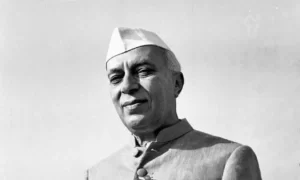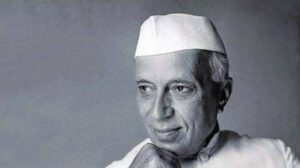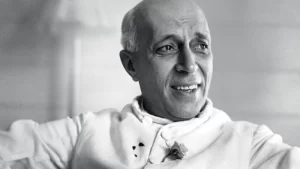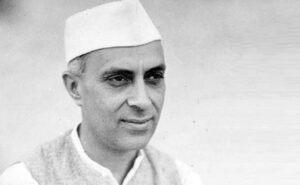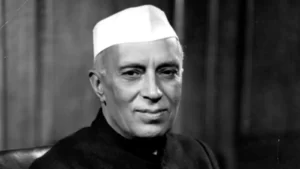Following text has been scanned from the book ‘Jawaharlal Nehru on Building a New India: A Construct of his sayings on art, architecture, heritage, cities and city planning, published by NIUA, 1991
The Arrangement | INTENTION & MEANING
To mark the Nehru Centenary, the National Institute of Urban Affairs presents, in this small volume, a composition of Jawaharlal Nehru’s views on Art, Architecture, Heritage, Cities and City Planning arranged around the human habitat in its myriad settings and interfaces within the broad spectrum of Nehru’s vision of building a new India. It was a passion for him and he called it a great adventure. One can discern that passion and feeling in his famous tryst with destiny’ speech he gave on India’s day of Independence. The speech concludes with an open invitation extended to all to “join and take part in the great adventure of building a new India.” He envisioned a future India befitting its formidable past but planned anew based on the complex mosaic of its unparallelled diversities and contrasts wherein every region and cultural stream contributes its share to the grand design.
Conceived as an anthology, the selections extracted from the writings and sayings of Jawaharlal Nehru are in the form of an arabesque a construct of several inter-related topics and issues. They have been arranged in a sequence that centres on the human habitat as its major focus; everything has been interwoven around it. The objective has been to select and assemble in one volume Jawaharlal’s views on issues and problems that still haunt us and have pertinence in India of today.
As the reader will discover, the selections in this monograph are related to each other as they go in making up the master plan for building a new and beautiful India, hopefully, as envisioned by Jawaharlal Nehru from time to time. It was a constant refrain throughout his life; from his student days to the gradual crystallization of his ideas which he expressed again and again and which inspired the young generations during his lifetime. His writings and speeches bear testimony to that quest. His Autobiography and Discovery of India and the number of letters he wrote from prison including those to his daughter, sister and nieces and later to his friends when he became India’s first Prime Minister reveal his enduring romance for a new India.
A brief scanning of his writings and speeches makes it clear that while he did not perceive urban India per se (for he seldom used the word: urban), nevertheless, the living habitat, be it rural or urban, was integral to his perception of a new, vibrant and progressive India. He was one of the few among the great galaxy of leaders that India had the good fortune to have during the freedom struggle, who had a rare vision. Indeed he liked dreaming and occasionally exhorted the young people to dream and dream of nice and beautiful things about their country and its people:
“I’m called a dreamer! I wish you’re called dreamers too, but your dreams should have some relation to reality.”
“And if youth will not dream, who else would? Do you expect those crabbed and aged people to dream?”
Jawaharlal Nehru had the innate desire, a passion to see India attain greatness, grace and beauty that it so richly deserved. It is remarkable to find that unlike others, he had a total view of things; his perspectives were all-encompassing. His was not a one-sided fragmented design or linear imagination; rather it was a comprehen sive and fully integrated one. Yet he was not a self-righteous egoist and conceded: “All of us I suppose, have varying pictures of our native land and no two persons will think exactly alike.” Deeply concerned about the human habitat, and, given his formid able historic perceptions, he did not consider urban and rural as two different things: to him they were two faces of one coin that were interdependent. Conscious of the crucial role that cities play in the life of a nation, he was equally concerned about the rural habitats: “I like to take many of the cultural advantages that the city life provides and I like some of the things which the village stands for. I like the city to approach the village and the village to approach the city.”
And declared:
“Nothing really mattered in India that could not be measured in terms of the village.”
His journeys into India’s history gave him rare insights and extraordinary perspectives. Books fascinated Jawaharlal Nehru and as Indira Gandhi points out in the Foreword to the Glimpses of World History: “he was extraordinarily sensitive to literary beauty… He was a luminous man and his writings reflected the radiance of his spirit.” A many-sided personality, his major contribution has been in the realm of ideas and his reliance on scientific temper in a country particularly prone to be overwhelmed by blind faith and superstition.
This book has three parts: the first one furnishes a glimpse of his myriad ideas and thoughts to serve as a setting in his quest for a better and more beautiful India; the second part covers the major theme the human habitat; while the third and the concluding part deals with the tasks ahead, the work that remains to be done in the field of social change and transforming the living conditions. In more than one sense, it is something “beyond the pen and the hand” because it deals with the state of mind and commitment to values and causes that remained near and dear to Jawaharlal. It is surprising to discover that they have an astonishing relevance to the present. Indeed, they should not be forgotten; for they can light the path in our endeavour to make India with its teeming villages, cities and towns, decent places to live and work and reflect and relax.
Spread over ten chapters (or sections), each set of quotations has titles either derived or inspired from the meticulous phrases and expressions so effortlessly and spontaneously crafted by Panditji himself. Promise of the Coming Day, Past in the Present, Life Through Action. Between a Curve and a Tangent. Planning Perspectives and Planning Paradoxes. On Cities that Represent and finally. Till we Reach….
The part on the Human Habitat includes two chapters dealing with cities with which Pandit Nehru was personally associated. They include Allahabad, Bhubaneshwar, Chandigarh and Delhi, and to a lesser extent, Bangalore and Calcutta. Jawaharlal was particularly involved about the planning and development of the two new capital cities of Bhubaneshwar and Chandigarh. As records indicate initially he was apprehensive about the building of a new capital for Punjab but later he became an ardent supporter of Chandigarh. Apparently, his enthusiasm and the egocentricity of Le Corbusier meshed together rather well! In his own words, Chandigarh was “to be symbolic of a new India, unfettered by the traditions of the past an expression of the nation’s faith in the future.”
At the other end of the city spectrum was Delhi, India’s traditional capital. a city that has witnessed the making and unmaking of history. With its unmatched history and heritage and representing the elusive ethos of India of repeated incarnations and re incarnations: birth-death-and-re-birth and like India, its uncanny ability to renew itself, Delhi was of great personal concern to Jawaharlal. To him Delhi was like no other city in India: “epitome of India’s history with its succession of glory and disaster, and with its great capacity to absorb many cultures and yet remain itself….A city where even the stones whisper in our ears of the ages of long ago and the air we breathe is full of the dust and fragrance of the past, as also of the fresh and piercing winds of the present… We face the good and bad of India in Delhi city which has been the grave of many empires and the nursery of a new republic.”
Nehru was close to the planners of Chandigarh, and, even more so in Delhi. He spent hours together with the town planners and was deeply interested in knowing their mind and learning their strange language. He was completely committed to the planned develop ment of the nation’s capital and other cities as well. Undoubtedly. he had a high regard and affection for planners. Alone among his cabinet colleagues, he asked questions on things that provoked his intellectual curiosity. He wanted to know how the “age-sex ratio is relevant to the planning of cities? What is meant by day-time and night-time population? What is height-zoning? And what are all the non-conforming uses; and what is that planners call as “origin-and destination” survey? Besides, what on earth, are the so-called “desire lines”?
Though occasionally impatient and, at times temperamental, he was never condescending. An orator, he was an avid listener, ever eager to know of new things; and new ideas never ceased to fascinate him. To the Delhi Planning Team, he provided instant solace and an abiding support because he had a first-hand know ledge of Delhi, besides he greatly admired its valuable contribution to India’s composite culture and architecture. He was fond of the walled city called Shahjahanabad, its magnificent heritage and he was greatly perturbed about the incredible agglomeration of activities in the propinquity of India’s most beautiful mosque, the Jama Musjid. He wanted its surroundings to be cleaned up.
Nehru was anxious to see Delhi develop as the befitting capital of an independent India along proper lines. In retrospect, his views on the influx of people into Delhi, the location of manufacturing industries, the unchecked proliferation of government offices and allied institutions are relevant now more than ever before. His abhorrence of re-naming the well-known streets and his intense dislike of installing statues of Mahatma Gandhi and other prominent leaders have contemporary pertinence.
About memorial to the Father of the Nation in the form of a statue, he said:
People talk of memorials to him (Gandhiji) in statues of bronze or marble or pillars and thus they mock him and belie his message. What tribute shall we pay to him that he would have appreciated? He has shown us the way to live and way to die and if we have not understood that lesson, it would be better that we raised no memorial to him; for the only fitting memorial is to follow reverently in the path he showed us and to do our dury in life and in death.
(Broadcast to the nation over All India Radio, 14 February 1948.)
His love for parks and playgrounds and green open spaces is well known. He wanted preservation of Delhi’s Ridge and the Yamuna riverfront:
“If you take the Jamuna, that very beautiful and gracious river, you get the whole of the Krishna legend around about Muttra and Brindaban and of the sweet songs of Brij Bhasa.”
A significant part of Delhi’s riverfront in its present form is a silent tribute to him. A chain of landscaped open spaces interlaced with the samadhis but basically open, green and afforested furnishes a positive asset to Delhi’s changed urbanscape. Almost all the earlier cities that came and vanished and some of the more important monuments have also been inter-linked through the wedges of landscaped-linkages in the form of mini city forests, something rather peculiar and unique to Delhi, and a singular achievement of Delhi’s first Master Plan.
These and many of his ideas are important today. He was deeply anguished at the plight of our traditional towns that form the inner core of many of our metropolitan cities like Ahmedabad. Allahabad. Jaipur Jodhpur, Hyderabad. Moradabad and Shahjahanabad, to name only a few.
Included in the selection are his views on local self government, community development and panchayati raj, and critical comments on old style of doing things, on bureaucratic inertia and the necessity of inducting technical expertise within the government setup
But nothing perturbed Jawaharlal more than the sight of the blighted areas and the sub-human living conditions in the slum areas. He considered them to be a slur on the fair face of his beloved country:
“Slums are a disease, which if not checked immediately, might well overshadow the beauty of our cities. There is no reason why slums should be allowed to grow.”
And declared: “I believe in no argument, economic or other, which is based on creation of slums. I have a horror of slums. I do not mind a person living in the open like a vagabond or a gypsy. I am a bit of vagabond myself and I like vagabonds and gypsies. I do not mind a person living in a mud-hut, I do mind slums in cities, and I have often said if you cannot provide buildings for those living in slums, give them open space to live in and give them some social services like water supply, and sanitation. The rest will follow.”
The slum distorted the picture he had painted in his mind of a new India where every household would have a decent dwelling to live in enabling latent talents to flower and creativity unleashed. He wanted the new communities, be they rural or urban, to have decent shelter, good schools and parks and playgrounds for all. He wanted that even the lowest of the low-income families should have a minimum of a two-room house. That was what he repeatedly told the planners of Chandigarh:
“I think housing must be given a high priority. We might not be able to change the face of India quickly. but we should proceed about it with some speed. I think that our normal approach to this has been wholly unsatisfactory.”
On another occasion, he expressed great impatience for the lethargy and slow motion of files in the government officers:
“One inch per day is not enough” and “To hell with the man who cannot walk fast. We want no sluggards. I want work and work and work…” To a sensitive person like Nehru, a great handicap was the prevailing poverty. Like slums, at times, he got exasperated with poverty, for he considered “poverty becomes its own curse… Underdevelopment repeats itself” And: “poverty is not a good thing; it is not to be exalted or praised, but an evil thing which must be fought and stamped out.”
On the other hand, there was nothing that provoked him as much as the exuberant vulgarity and the unabashed display by the rich. He often said that the real capital of a person as also of a nation is the “intellectual and the capacity for hardwork and that is one thing that no one can take away.” While he absorbed and imbibed the: rich heritage and had the ability to identify the noble traditions of the past, his commitment to improve the living conditions was to be through the application of scientific method; for translating his dreams into reality, he dependend upon planning and planned development. Despite his vast knowledge and scholarship. he remained modest:
“We may be specks of dust on a soup-bubble universe, but that speck of dust contains something that is the mind and spirit of men. Through the ages this has grown and made itself master of this earth and drawn power from its innermost bowels as well as from the thunderbolt in the skies. It has tried to fathom the secrets of the universe and bought the vagaries of nature itself to its own use. More wonderful than the earth and the heavens is this mind and spirit of man which grows mightier and seeks fresh worlds to conquer
But he reiterated: “The sign of any living thing is in its capacity to grow and change. The moment its growth is stopped, it is dead.” While he acknowledged the rich endowments of the heritage, he warned:
“Nothing is more advantageous and more creditable than a rich heritage, but nothing is more dangerous for a nation than to sit back and live on that heritage. A nation cannot progress if it merely imitates its ancestors: What builds a nation is creative inventions and vital activity. I seek the creative mind.”
And surmised: “Life has to be seen as a whole, as an integrated whole…. That greatness comes from visions, tolerance of spirit, compassion and even temper that is not ruffled by ill fortune or good fortune alike.” But, then even his dreams were tempered by an innate sense of realism: “Nevertheless, we cannot just disrupt and hope for something better without having some vision of the future we are working for, however vague that vision may be.”
Given the complex nature of problems faced by India and its vast diversities and contrasts. Nehru emphasised the role of perspective planning:
“Indeed, perspective planning is the essence of the planning process…and ultimately, it is development of the human being and the human personality that counts. Although planning involves material investment, even more important is the investment in man.”
He advised the young: “Do not limit your vision. You must think of things ahead and think of the future.” Though Jawaharlal loathed to give advice, nonetheless his saying: “You should not accept or tolerate ugliness anywhere in your activities, in your buildings” must be remembered by all engaged in planning and building of a new and beautiful India.
Recognising the increasing pace of urbanisation with our towns and cities multiplying, he desired: “What I should like in regard to every city is a clear plan of what a city will be like, say, twenty or thirty years later.”
The monograph concludes with the tasks ahead and things that are beyond the pen and the hand:
“I dare not look into the crystal ball any more but have given you some vague idea of how I look at the future of India. That gives me hope and sense of function. After all, it will be for the others to decide and to work for this future India.” And made us remember that “there is no journey’s end when a nation is marching: you know we have to carry on till we reach our goal.”



